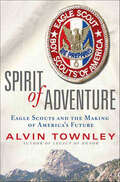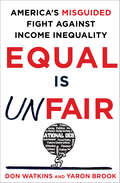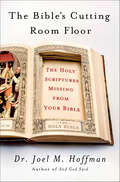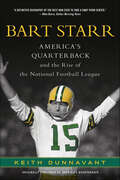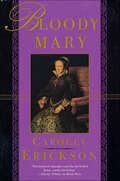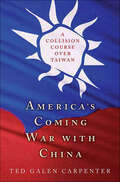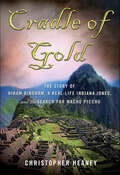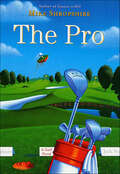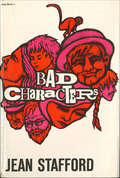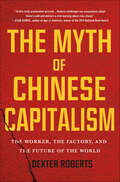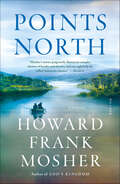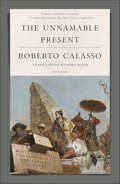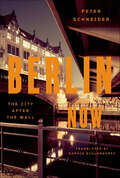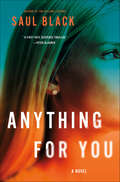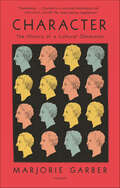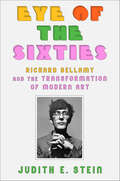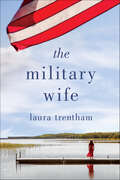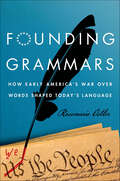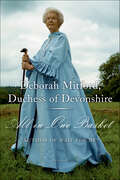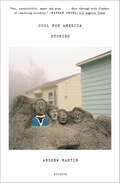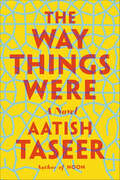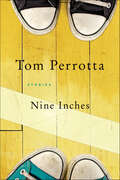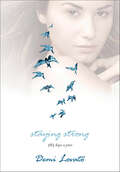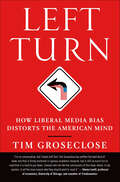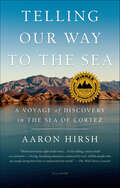- Table View
- List View
Spirit of Adventure: Eagle Scouts and the Making of America's Future
by Alvin TownleyAn extraordinary journey alongside America's new generation of Eagle Scouts, who are discovering their purpose and bringing the values of Scouting to the world.Over the past century, Scouts have helped to guide the course of American history. But what does Scouting and the Eagle badge mean to the Scouts of today? How will they shape the future of Scouting and America itself? In Spirit of Adventure, Scouting expert and Eagle Scout Alvin Townley finds the answer.Townley traveled across the country and to the far corners of the globe to meet these young Eagle Scouts. He found them everywhere, continuing the life of adventure and service that they had begun in Scouting. He discovered them in Afghanistan providing medical care to villagers, in Australia saving coral reefs, at the Super Bowl and Olympic venues striving for victory, on desert cliffs and at inner-city schools teaching new lessons, in Africa bringing hope to children, and on the windswept deck of the aircraft carrier USS Nimitz preparing for takeoff.Whether doctors, activists, servicemen, entrepreneurs, or teachers, these young men are changing the world through bold actions that capture the essence of the Scouting tradition. In Spirit of Adventure, Townley answers important questions about the future of Scouting and America, while revealing stories of service, courage, and pure excitement that introduce our nation to an inspiring new generation of leaders.
Equal Is Unfair: America's Misguided Fight Against Income Inequality
by Don Watkins Yaron BrookWe’ve all heard that the American Dream is vanishing, and that the cause is rising income inequality. The rich are getting richer by rigging the system in their favor, leaving the rest of us to struggle just to keep our heads above water. To save the American Dream, we’re told that we need to fight inequality through tax hikes, wealth redistribution schemes, and a far higher minimum wage.But what if that narrative is wrong? What if the real threat to the American Dream isn’t rising income inequality—but an all-out war on success?In Equal is Unfair, a timely and thought-provoking work, Don Watkins and Yaron Brook reveal that almost everything we’ve been taught about inequality is wrong. You’ll discover:• why successful CEOs make so much money—and deserve to• how the minimum wage hurts the very people it claims to help• why middle-class stagnation is a myth• how the little-known history of Sweden reveals the dangers of forced equality• the disturbing philosophy behind Obama’s economic agenda.The critics of inequality are right about one thing: the American Dream is under attack. But instead of fighting to make America a place where anyone can achieve success, they are fighting to tear down those who already have. The real key to making America a freer, fairer, more prosperous nation is to protect and celebrate the pursuit of success—not pull down the high fliers in the name of equality.
The Bible's Cutting Room Floor: The Holy Scriptures Missing from Your Bible
by Joel M. HoffmanThe Bible you usually read is not the complete story. Some holy writings were left out for political or theological reasons, others simply because of the physical restrictions of ancient bookmaking technology. At times, the compilers of the Bible skipped information that they assumed everyone knew. Some passages were even omitted by accident.In The Bible's Cutting Room Floor, acclaimed author and translator Dr. Joel M. Hoffman gives us the stories and other texts that didn't make it into the Bible even though they offer penetrating insight into the Bible and its teachings.The Book of Genesis tells us about Adam and Eve's time in the Garden of Eden, but not their saga after they get kicked out or the lessons they have for us about good and evil. The Bible introduces us to Abraham, but it doesn't include the troubling story of his early life, which explains how he came to reject idolatry to become the father of monotheism. And while there are only 150 Psalms in today's Bible, there used to be many more.Dr. Hoffman deftly brings these and other ancient scriptural texts to life, exploring how they offer new answers to some of the most fundamental and universal questions people ask about their lives. An impressive blend of history, linguistics, and religious scholarship, The Bible's Cutting Room Floor reveals what's missing from your Bible, who left it out, and why it is so important.
Bart Starr: America's Quarterback and the Rise of the National Football League
by Keith DunnavantThe definitive, authorized biography of Bart Starr, quarterback for the University of Alabama and for the Green Bay Packers during the 1960s. A must-read for fans of the Crimson Tide, the Packers, and football greats.No one can touch Bart Starr's record setting 5 NFL Championships including 3 straight. America's Quarterback tells the story of the man who helped create the legend of Vince Lombardi and the Green Bay Packers. Set against the changing landscape of the last half of the 20th century, this biography traces Starr's life from childhood in Alabama to stardom in Green Bay and beyond. Not a simple sports story, Keith Dunnavant traces the story of one man reaching for the American dream while professional football emerged from the shadows to capture the nation's imagination. It's a story of the tension between a coach and a player as different as fire and ice, and how they came to trust and revere each other. It's a story of triumph tempered by tragedy, and the world-class athlete who quietly, persistently, achieved a level of greatness unsurpassed by any quarterback since.A remarkable blend of personal memory and historical narrative, Bart Starr: America's Quarterback and the Rise of the National Football League is a tribute to an American hero and the perfect companion to the classic When Pride Still Mattered.
Bloody Mary
by Carolly EricksonHere is the tragic, stormy life of Mary Tudor, daughter of Henry VIII and Katherine of Aragon. Her story is a chronicle of courage and faith, betrayal and treachery-set amidst the splendor, pageantry, squalor, and intrigue of sixteenth-century Europe.The history of Mary Tudor is an improbable blend of triumph, humiliation, heartbreak, and devotion-and Ms. Erickson recounts it all against the turbulent background of European politics, war, and religious strife of the mid-1500s. The result is a rare portrait of the times and of a woman elevated to unprecedented power in a world ruled and defined by men.
America's Coming War with China: A Collision Course over Taiwan
by Ted Galen CarpenterOne issue could lead to a disastrous war between the United States and China: Taiwan. A growing number of Taiwanese want independence for their island and regard mainland China as an alien nation. Mainland Chinese consider Taiwan a province that was stolen from China more than a century ago, and their patience about getting it back is wearing thin. Washington officially endorses a "one China" policy but also sells arms to Taiwan and maintains an implicit pledge to defend it from attack. That vague, muddled policy invites miscalculation by Taiwan or China or both. The three parties are on a collision course, and unless something dramatic changes, an armed conflict is virtually inevitable within a decade. Although there is still time to avert a calamity, time is running out. In this book, Carpenter tells the reader what the U.S. must do quickly to avoid being dragged into war.
Cradle of Gold: The Story of Hiram Bingham, a Real-Life Indiana Jones, and the Search for Machu Picchu
by Christopher HeaneyIn 1911, a young Peruvian boy led an American explorer and Yale historian named Hiram Bingham into the ancient Incan citadel of Machu Picchu. Hidden amidst the breathtaking heights of the Andes, this settlement of temples, tombs and palaces was the Incas' greatest achievement. Tall, handsome, and sure of his destiny, Bingham believed that Machu Picchu was the Incas' final refuge, where they fled the Spanish Conquistadors. Bingham made Machu Picchu famous, and his dispatches from the jungle cast him as the swashbuckling hero romanticized today as a true Indiana Jones-like character. But his excavation of the site raised old specters of conquest and plunder, and met with an indigenous nationalism that changed the course of Peruvian history. Though Bingham successfully realized his dream of bringing Machu Picchu's treasure of skulls, bones and artifacts back to the United States, conflict between Yale and Peru persists through the present day over a simple question: Who owns Inca history?In this grand, sweeping narrative, Christopher Heaney takes the reader into the heart of Peru's past to relive the dramatic story of the final years of the Incan empire, the exhilarating recovery of their final cities and the thought-provoking fight over their future. Drawing on original research in untapped archives, Heaney vividly portrays both a stunning landscape and the complex history of a fascinating region that continues to inspire awe and controversy today.
The Pro: A Golf Novel
by Mike ShropshireDel Bonnet, a teaching pro at an obscure Florida golf resort, needs a change and needs it badly. Having crossed an ominous threshold--his fiftieth birthday--Bonnet receives frequent communiques from the AARP people. He gazes into the future and sees the prospect of assisted living growing larger by the day.Serendipity intervenes. A sales rep working out of his station wagon leaves a handmade driver in Bonnet's modest golf shop. The pro privately auditions the driver with astounding results. Bonnet--celebrated for thirty years as the only touring pro to be arrested on the course during a PGA event--is quickly convinced that he has secured possession of no mere golf club, but a sword of salvation. So armed, he decides to embark on the PGA Seniors Tour. Thus the formation of a strange triumvirate known as Team Del, consisting of the pro, the golf club that soon becomes dubbed "Big Luther," and a caddie, Doublewide McBride. Bonnet soon learns that the caddie is long on off-the-wall intuitions, short on behavioral graces recommended by Emily Post. While the misadventures of Team Del might not serve as a tribute to the memories Hagen and Hogan, the events detailed in Michael Shropshire's The Pro stand out as perhaps the most hilarious odyssey in the modern annals of sports fiction.
Bad Characters: Stories
by Jean StaffordThis book displays at their height the wit, sensibility and psychological penetration that distinguish Miss Stafford's work. There are nine stories and a novella. They range in mood from the title story, a comic portrait of a resourceful child-criminal named Lottie Jump, to "The End of a Career," an elegiac and ironic tale of the declining years of a great beauty. In "A Reasonable Facsimile" Dr. Bohrmann, a retired professor philosophy, is unexpectedly rescued from an aggressively boring young house guest. "Cops and Robbers" is a chilling story of childhood horror and lovelessness that revolves around a father's trip to the barber with his five-year-old daughter.Several of the stories have as their common setting Miss Stafford's fiction town of Adams, Colorado—including an amusing saga of a girl's frustrated attempts to find a quiet spot to read ("A Reading Problem"), and two stories of failure ("In the Zoo") and success ("The Liberation") in the effort to escape from one's family. "Caveat Emptor" is a satire on the academic life and sub-life at the Alma Hettrick College for Girls; and in "The Captain's Gift" the sheltered and lavender-scented existence of old Mrs. Ramsey is violated by the reality of war.The major piece in Bad Characters is "A Winter's Tale," a haunting and evocative novella set in Heidelberg just before the outbreak of the war. It is dominated by the diabolic character of Frau Professor Persis Galt. This portrait of a former Bostonian who poses as an excessively devout convert is one of Miss Stafford's most brilliant fictional creations.This collection by Jean Stafford will be warmly welcomed by the many and devoted admirers of her novels and stories. To new readers the work of one of the best writers of our time will come as a joyful discovery.
The Myth of Chinese Capitalism: The Worker, the Factory, and the Future of the World
by Dexter RobertsThe untold story of how restrictive policies are preventing China from becoming the world’s largest economyDexter Roberts lived in Beijing for two decades working as a reporter on economics, business and politics for Bloomberg Businessweek. In The Myth of Chinese Capitalism, Roberts explores the reality behind today’s financially-ascendant China and pulls the curtain back on how the Chinese manufacturing machine is actually powered.He focuses on two places: the village of Binghuacun in the province of Guizhou, one of China’s poorest regions that sends the highest proportion of its youth away to become migrants; and Dongguan, China’s most infamous factory town located in Guangdong, home to both the largest number of migrant workers and the country’s biggest manufacturing base. Within these two towns and the people that move between them, Roberts focuses on the story of the Mo family, former farmers-turned-migrant-workers who are struggling to make a living in a fast-changing country that relegates one-half of its people to second-class status via household registration, land tenure policies and inequality in education and health care systems. In The Myth of Chinese Capitalism, Dexter Roberts brings to life the problems that China and its people face today as they attempt to overcome a divisive system that poses a serious challenge to the country’s future development. In so doing, Roberts paints a boot-on-the-ground cautionary picture of China for a world now held in its financial thrall.Dexter Roberts is an award-winning journalist and a regular commentator on the U.S.-China trade and political relationship. His prior speaking engagements include traditional news media outlets (NPR, Fox News, CNN International) as well as universities and institutes (George Washington University, Council on Foreign Relations, and the Overseas Press Club). He is available for virtual classroom visits to courses that adopt The Myth of Chinese Capitalism. Please contact academic@macmillan.com for more information.
Points North: Stories
by Howard Frank MosherThe final book by one of America’s most treasured writers.Upon his passing in January 2017, Howard Frank Mosher was recognized as one of America’s most acclaimed writers. His fiction set in the world of Vermont’s fabled Northeast Kingdom chronicles the intertwining family histories of the natives, wanderers, outcasts, and others who settled in this ethereal place. In its obituary, The New York Times wrote, “Mr. Mosher’s fictional Kingdom County, Vt., became his New England version of Faulkner’s Yoknapatawpha County.” In Points North, completed just weeks before his death, Mosher presents a brilliant, lovingly-evoked collection of stories that center around the Kinneson family, ranging over decades of their history in the Kingdom. From a loquacious itinerant preacher who beguiles the reticent farmers and shopkeepers of a small New England town, to a proposed dam that threatens the river that Kinneson men have fished for generations, the scandalous secret of a romance and its violent consequences, and a young man’s seemingly fruitless search for love—Points North is a full-hearted, gently-comic, and beautifully-written last gift to the readers who treasure Howard Frank Mosher.
The Unnamable Present
by Roberto CalassoA decisive key to help grasp some of the essential points of what is happening around us. The ninth part of Roberto Calasso’s masterwork, The Unnamable Present, is closely connected with themes of the first book, The Ruin of Kasch (originally published in 1983, and reissued by FSG in a new translation). But while Kasch is an enlightened exploration of modernity, The Unnamable Present propels us into the twenty first century.Tourists, terrorists, secularists, fundamentalists, hackers, transhumanists, algorithmicians: these are all tribes that inhabit the unnamable present and act on its nervous system. This is a world that seems to have no living past, but was foreshadowed in the period between 1933 and 1945, when everything appeared bent on self-annihilation. The Unnamable Present is a meditation on the obscure and ubiquitous process of transformation happening today in all societies, which makes so many previous names either inadequate or misleading or a parody of what they used to mean.Translated with sensitivity by Calasso’s longtime translator, Richard Dixon, The Unnamable Present is a strikingly original and provocative vision of our times, from the writer The Paris Review called “a literary institution of one.”
Berlin Now: The City After the Wall
by Peter SchneiderA smartly guided romp, entertaining and enlightening, through Europe's most charismatic and enigmatic cityIt isn't Europe's most beautiful city, or its oldest. Its architecture is not more impressive than that of Rome or Paris; its museums do not hold more treasures than those in Barcelona or London. And yet, when citizens of "New York, Tel Aviv, or Rome ask me where I'm from and I mention the name Berlin," writes Peter Schneider, "their eyes instantly light up."Berlin Now is a longtime Berliner's bright, bold, and digressive exploration of the heterogeneous allure of this vibrant city. Delving beneath the obvious answers—Berlin's club scene, bolstered by the lack of a mandatory closing time; the artistic communities that thrive due to the relatively low (for now) cost of living—Schneider takes us on an insider's tour of Germany's rapidly metamorphosing metropolis, where high-class soirees are held at construction sites and enterprising individuals often accomplish more without public funding—assembling a makeshift club on the banks of the Spree River—than Berlin's officials do. Schneider's perceptive, witty investigations on everything from the insidious legacy of suspicion instilled by the East German secret police to the clashing attitudes toward work, food, and love held by former East and West Berliners have been sharply translated by Sophie Schlondorff. The result is a book so lively that readers will want to jump on a plane—just as soon as they've finished their adventures on the page.
Anything for You: A Novel (Valerie Hart #3)
by Saul Black"The writing is sharp as the devil." —Stephen KingCritically acclaimed author Saul Black returns with a heart-racing thriller in which a brutal murder forces one woman to reckon with her own past—and her future.On a hot summer night, a watchful neighbor locks eyes with an intruder and unwittingly alerts the police to a vicious crime scene next door: a lavish master bedroom where a man lies dead. Next to him, his wife is bleeding out onto the hardwood floor, clinging to life. The victim, Adam Grant, was a well-known San Francisco prosecutor—a man whose connection to Homicide detective Valerie Hart brings her face-to-face with a life she’s long since left behind. Adam’s career made him an easy target, and forensic evidence points towards an ex-con he put behind bars years ago. But while Adam’s wife and daughter grapple with their tragic loss, Valerie uncovers devastating clues that point in a more ominous direction. Lurking in the shadows of the Grants’ pristine life is a mysterious blonde who holds the key to a very different—and much darker—story. As Valerie struggles to forge a new path for herself, the investigation forces her to confront the question: can we ever really leave our pasts behind? Sophisticated and stunning, Anything for You is an unforgettable thriller that will grip readers long after turning the last page.
Character: The History of a Cultural Obsession
by Marjorie GarberWhat is “character”?Since at least Aristotle’s time, philosophers, theologians, moralists, artists, and scientists have pondered the enigma of human character. In its oldest usage, “character” derives from a word for engraving or stamping, yet over time, it has come to mean a moral idea, a type, a literary persona, and a physical or physiological manifestation observable in works of art and scientific experiments. It is an essential term in drama and the focus of self-help books. In Character: The History of a Cultural Obsession, Marjorie Garber points out that character seems more relevant than ever today, omnipresent in discussions of politics, ethics, gender, morality, and the psyche. References to character flaws, character issues, and character assassination and allegations of “bad” and “good” character are inescapable in the media and in contemporary political debates. What connection does “character” in this moral or ethical sense have with the concept of a character in a novel or a play? Do our notions about fictional characters catalyze our ideas about moral character? Can character be “formed” or taught in schools, in scouting, in the home? From Plutarch to John Stuart Mill, from Shakespeare to Darwin, from Theophrastus to Freud, from nineteenth-century phrenology to twenty-first-century brain scans, the search for the sources and components of human character still preoccupies us. Today, with the meaning and the value of this term in question, no issue is more important, and no topic more vital, surprising, and fascinating. With her distinctive verve, humor, and vast erudition, Marjorie Garber explores the stakes of these conflations, confusions, and heritages, from ancient Greece to the present day.
Eye of the Sixties: Richard Bellamy and the Transformation of Modern Art
by Judith E. SteinIn 1959, Richard Bellamy was a witty, poetry-loving beatnik on the fringe of the New York art world who was drawn to artists impatient for change. By 1965, he was representing Mark di Suvero, was the first to show Andy Warhol’s pop art, and pioneered the practice of “off-site” exhibitions and introduced the new genre of installation art. As a dealer, he helped discover and champion many of the innovative successors to the abstract expressionists, including Claes Oldenburg, James Rosenquist, Donald Judd, Dan Flavin, Walter De Maria, and many others. The founder and director of the fabled Green Gallery on Fifty-Seventh Street, Bellamy thrived on the energy of the sixties. With the covert support of America’s first celebrity art collectors, Robert and Ethel Scull, Bellamy gained his footing just as pop art, minimalism, and conceptual art were taking hold and the art world was becoming a playground for millionaires. Yet as an eccentric impresario dogged by alcohol and uninterested in profits or posterity, Bellamy rarely did more than show the work he loved. As fellow dealers such as Leo Castelli and Sidney Janis capitalized on the stars he helped find, Bellamy slowly slid into obscurity, becoming the quiet man in oversize glasses in the corner of the room, a knowing and mischievous smile on his face.Born to an American father and a Chinese mother in a Cincinnati suburb, Bellamy moved to New York in his twenties and made a life for himself between the Beat orbits of Provincetown and white-glove events like the Guggenheim’s opening gala. No matter the scene, he was always considered “one of us,” partying with Norman Mailer, befriending Diane Arbus and Yoko Ono, and hosting or performing in historic Happenings. From his early days at the Hansa Gallery to his time at the Green to his later life as a private dealer, Bellamy had his finger on the pulse of the culture. Based on decades of research and on hundreds of interviews with Bellamy’s artists, friends, colleagues, and lovers, Judith E. Stein’s Eye of the Sixties rescues the legacy of the elusive art dealer and tells the story of a counterculture that became the mainstream. A tale of money, taste, loyalty, and luck, Richard Bellamy’s life is a remarkable window into the art of the twentieth century and the making of a generation’s aesthetic.--"Bellamy had an understanding of art and a very fine sense of discovery. There was nobody like him, I think. I certainly consider myself his pupil." --Leo Castelli
The Military Wife: A Heart Of A Hero Novel (Heart Of A Hero Ser. #1)
by Laura TrenthamA young widow embraces a second chance at life when she reconnects with those who understand the sacrifices made by American soldiers and their families in award-winning author Laura Trentham’s The Military Wife.Harper Lee Wilcox has been marking time in her hometown of Kitty Hawk, North Carolina since her husband, Noah Wilcox’s death, nearly five years earlier. With her son Ben turning five and living at home with her mother, Harper fights a growing restlessness, worried that moving on means leaving the memory of her husband behind.Her best friend, Allison Teague, is dealing with struggles of her own. Her husband, a former SEAL that served with Noah, was injured while deployed and has come home physically healed but fighting PTSD. With three children underfoot and unable to help her husband, Allison is at her wit’s end.In an effort to reenergize her own life, Harper sees an opportunity to help not only Allison but a network of other military wives eager to support her idea of starting a string of coffee houses close to military bases around the country.In her pursuit of her dream, Harper crosses paths with Bennett Caldwell, Noah’s best friend and SEAL brother. A man who has a promise to keep, entangling their lives in ways neither of them can foresee. As her business grows so does an unexpected relationship with Bennett. Can Harper let go of her grief and build a future with Bennett even as the man they both loved haunts their pasts?
Founding Grammars: How Early America's War Over Words Shaped Today's Language
by Rosemarie OstlerWho decided not to split infinitives? With whom should we take issue if in fact, we wish to boldly write what no grammarian hath writ before? In Founding Grammars, Rosemarie Ostler delves into the roots of our grammar obsession to answer these questions and many more. Standard grammar and accurate spelling are widely considered hallmarks of a good education, but their exact definitions are much more contentious - capable of inciting a full-blown grammar war at the splice of a comma, battles readily visible in the media and online in the comments of blogs and chat rooms. With an accessible and enthusiastic journalistic approach, Ostler considers these grammatical shibboleths, tracing current debates back to America's earliest days, an era when most families owned only two books - the Bible and a grammar primer. Along the way, she investigates colorful historical characters on both sides of the grammar debate in her efforts to unmask the origins of contemporary speech. Linguistic founding fathers like Noah Webster, Tory expatriate Lindley Murray, and post-Civil War literary critic Richard Grant White,all play a featured role in creating the rules we've come to use, and occasionally discard, throughout the years. Founding Grammars is for curious readers who want to know where grammar rules have come from, where they've been, and where they might go next.
All in One Basket: A Memoir
by Deborah MitfordIn her beguiling memoir, Wait for Me!, Deborah Mitford, Duchess of Devonshire (and the youngest of the famously witty brood of writers, agitators, and icons), recounted her eventful life with wit and grace. All in One Basket collects the Duchess of Devonshire's breezy, occasional writings and provides a disarming look at a life lived with great zest and originality.All in One Basket combines two earlier collections, Counting My Chickens and Home to Roost, its sequel, which was never published in the United States. In these pages, we hear anecdotes about famous friends from Evelyn Waugh to John F. Kennedy; tales of struggle and success at Chatsworth, England's greatest stately home; and of course the tales of her beloved chickens, which the Duchess began raising as a child for pocket money. In All in One Basket, glamorous recollections happily coexist with practical insights into country life, and the result is a revelatory, intimate portrait of a woman described by The New York Times as a "national treasure."
Cool for America: Stories
by Andrew MartinExpanding the world of his classic-in-the-making debut novel Early Work, Andrew Martin’s Cool for America is a hilarious collection of overlapping stories that explores the dark zone between artistic ambition and its achievementThe collection is bookended by the misadventures of Leslie, a young woman (first introduced in Early Work) who moves from New York to Missoula, Montana to try to draw herself out of a lingering depression, and, over the course of the book, gains painful insight into herself through a series of intense friendships and relationships.Other stories follow young men and women, alone and in couples, pushing hard against, and often crashing into, the limits of their abilities as writers and partners. In one story, two New Jersey siblings with substance-abuse problems relapse together on Christmas Eve; in another, a young couple tries to make sense of an increasingly unhinged veterinarian who seems to be tapping, deliberately or otherwise, into the unspoken troubles between them. In tales about characters as they age from punk shows and benders to book clubs and art museums, the promise of community acts—at least temporarily—as a stay against despair.Running throughout Cool for America is the characters’ yearning for transcendence through art: the hope that, maybe, the perfect, or even just the good-enough sentence, can finally make things right.
The Way Things Were: A Novel
by Aatish TaseerAn absorbing family saga set amid the commotion of the last forty years of Indian historyThe Way Things Were opens with the death of Toby, the Maharaja of Kalasuryaketu, a Sanskritist who has not set foot in India for two decades. Moving back and forth across three sections, between today's Delhi and the 1970s, '80s, and '90s in turn, the novel tells the story of a family held at the mercy of the times. A masterful interrogation of the relationships between past and present and among individual lives, events, and culture, Aatish Taseer's The Way Things Were takes its title from the Sanskrit word for history, itihasa, whose literal translation is "the way things indeed were." Told in prose that is at once intimate and panoramic, and threaded through with Sanskrit as central metaphor and chorus, this is a hugely ambitious and important book, alive to all the commotion of the last forty years but never losing its brilliant grasp on the current moment.
Nine Inches: Stories
by Tom PerrottaA stunning short story collection from the New York Times bestselling author of The Leftovers and Little Children, featuring stories focusing on Tom Perrotta's familiar suburban nuclear familiesNine Inches, Perrotta's first true collection, features ten stories—some sharp and funny, some mordant and surprising, and a few intense and disturbing. Whether he's dropping into the lives of two teachers—and their love lost and found—in "Nine Inches", documenting the unraveling of a dad at a Little League game in "The Smile on Happy Chang's Face", or gently marking the points of connection between an old woman and a benched high school football player in "Senior Season", Perrotta writes with a sure sense of his characters and their secret longings.Nine Inches contains an elegant collection of short fiction: stories that are as assured in their depictions of characters young and old, established and unsure, as any written today.
Staying Strong: 365 Days a Year
by Demi LovatoDemi Lovato wakes up each morning and affirms her commitment to herself—to her health, her happiness, her being. Those commitments are the bedrock of her recovery and her work helping other young people dealing with the issues she lives with every single day. Demi is a platinum-selling recording artist whose latest album—DEMI—is already a smash hit. She's about to embark on her second season as a judge on X-Factor, and just launched The Lovato Treatment Scholarship Program. And she is an outspoken advocate for young people everywhere. Demi is also a young woman finding her way in the world. She has dealt deftly with her struggles in the face of public scrutiny, and she has always relied, not just on friends and family, but daily affirmations of her self-worth and value. Affirmations that steady her days and strengthen her resolve. Those affirmations have grown into STAYING STRONG, a powerful 365-day collection of Demi's most powerful, honest, and hopeful insights. Each day will provide the readers with a quote, a personal reflection and a goal. These are Demi's words. Words she lives by and shares with the people she loves and total strangers alike. They are a powerful testament to a young woman standing up and fighting back.
Left Turn: How Liberal Media Bias Distorts the American Mind
by Tim GrosecloseA leading political science professor provides scientific proof of media bias in this sure-to-be-controversial bookDr. Tim Groseclose, a professor of political science and economics at UCLA, has spent years constructing precise, quantitative measures of the slant of media outlets. He does this by measuring the political content of news, as a way to measure the PQ, or "political quotient" of voters and politicians. Among his conclusions are: (i) all mainstream media outlets have a liberal bias; and (ii) while some supposedly conservative outlets—such the Washington Times or Fox News' Special Report—do lean right, their conservative bias is less than the liberal bias of most mainstream outlets. Groseclose contends that the general leftward bias of the media has shifted the PQ of the average American by about 20 points, on a scale of 100, the difference between the current political views of the average American, and the political views of the average resident of Orange County, California or Salt Lake County, Utah. With Left Turn readers can easily calculate their own PQ—to decide for themselves if the bias exists. This timely, much-needed study brings fact to this often overheated debate.
Telling Our Way to the Sea: A Voyage of Discovery in the Sea of Cortez
by Aaron HirshA luminous and revelatory journey into the science of life and the depths of the human experienceBy turns epic and intimate, Telling Our Way to the Sea is both a staggering revelation of unraveling ecosystems and a profound meditation on our changing relationships with nature—and with one another.When the biologists Aaron Hirsh and Veronica Volny, along with their friend Graham Burnett, a historian of science, lead twelve college students to a remote fishing village on the Sea of Cortez, they come upon a bay of dazzling beauty and richness. But as the group pursues various threads of investigation—ecological and evolutionary studies of the sea, the desert, and their various species of animals and plants; the stories of local villagers; the journals of conquistadors and explorers—they recognize that the bay, spectacular and pristine though it seems, is but a ghost of what it once was. Life in the Sea of Cortez, they realize, has been reshaped by complex human ideas and decisions—the laws and economics of fishing, property, and water; the dreams of developers and the fantasies of tourists seeking the wild; even efforts to retrieve species from the brink of extinction—all of which have caused dramatic upheavals in the ecosystem. It is a painful realization, but the students discover a way forward. After weathering a hurricane and encountering a rare whale in its wake, they come to see that the bay's best chance of recovery may in fact reside in our own human stories, which can weave a compelling memory of the place. Glimpsing the intricate and ever-shifting web of human connections with the Sea of Cortez, the students comprehend anew their own place in the natural world—suspended between past and future, teetering between abundance and loss. The redemption in their difficult realization is that as they find their places in a profoundly altered environment, they also recognize their roles in the path ahead, and ultimately come to see one another, and themselves, in a new light.In Telling Our Way to the Sea, Hirsh's voice resounds with compassionate humanity, capturing the complex beauty of both the marine world he explores and the people he explores it with. Vibrantly alive with sensitivity and nuance, Telling Our Way to the Sea transcends its genre to become literature.
